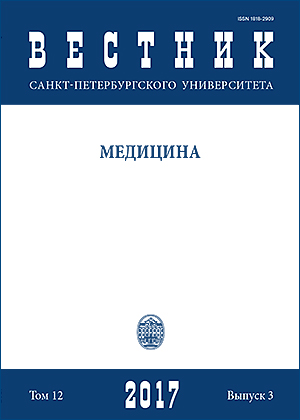ДИСТИМИЯ: ОСОБЕННОСТИ ПСИХОПАТОЛОГИИ И ПРОТЕКТИВНЫХ СТРУКТУР И ИХ ДИНАМИКА В ТЕРАПИИ*
DOI:
https://doi.org/10.21638/11701/spbu11.2017.305Аннотация
В статье излагаются основные результаты собственного исследования протективных психологических механизмов (копинг-стратегий, механизмов психологической защиты у больных дистимией), а также их динамики в процессе терапии. В результате терапии у лиц с дистимией по опроснику SCL-90-R достоверно снижаются показатели соматизации, межличностной сензитивности, депрессии, что свидетельствует о снижении дистресса, возникающего от осознания нарушений функций тела, минимизации ощущения личной неадекватности и неполноценности, а также признаков угасания интереса к деятельности. В результате групповой когнитивно-поведенческой психотерапии установлено достоверное снижение использования неадаптивных копингов в поведенческой сфере и укрепление адаптивных вариантов поведения.Кроме того, у больных дистимией стали более зрелыми механизмы психологических защит, например в арсенале поведения появилась «интеллектуализация». Библиогр. 19 назв. Табл. 6.
Ключевые слова:
дистимия, копинг, механизмы психологической защиты, когнитивно- поведенческая психотерапия
Скачивания
Библиографические ссылки
References
Fawcett J. A., Koran L. M., Klein D. N., Russell J. M., Kornstein S. G., McCullough J. P., Davis S. M., Harrison W. M. The treatment of chronic depression, part 2: a double-blind, randomized trial of sertraline and imipramine.J. Clin. Psychiatry, 1998, vol. 59, pp. 598–607.
clusters within dysthymia: a study of 512 out-patients without major depression. J. Affect. Disord., 1999,vol. 5, no. 1, pp. 17–25.
Griffiths J. Treatment of primary dysthymia with group cognitive therapy and pharmacotherapy: clinical
symptoms and functional impairments. Am. J. Psychiatry, 1999, vol. 156, no. 10, pp. 1608–1617.
versus fluoxetine in the treatment of dysthymic disorder. Depression, 1996, no. 4, pp. 34–41.
Загрузки
Опубликован
Как цитировать
Выпуск
Раздел
Лицензия
Статьи журнала «Вестник Санкт-Петербургского университета. Медицина» находятся в открытом доступе и распространяются в соответствии с условиями Лицензионного Договора с Санкт-Петербургским государственным университетом, который бесплатно предоставляет авторам неограниченное распространение и самостоятельное архивирование.




